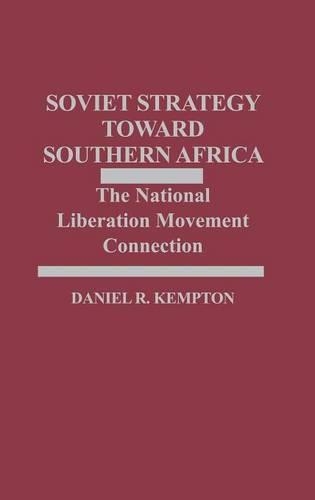
Soviet Strategy Toward Southern Africa: The National Liberation Movement Connection
(Hardback)
Publishing Details
Soviet Strategy Toward Southern Africa: The National Liberation Movement Connection
By (Author) Daniel R. Kempton
Bloomsbury Publishing PLC
Praeger Publishers Inc
15th May 1989
United States
Classifications
Tertiary Education
Non Fiction
327.0967
Physical Properties
Hardback
261
Width 156mm, Height 235mm
907g
Description
This study is the first significant work to examine Soviet involvement with national liberation movements (NLMs) in Africa as a separate subcategory of Soviet foreign policy in the developing world. The text compares and contrasts actual Soviet behavior with declared policy. Daniel R. Kempton presents three case studies: the African National Congress (ANC) in South Africa, The Movimento Popular de Libertacao de Angola (MPLA) and the Zimbabwe African People's Union (ZAPU). These cases trace the development of the Soviet Union's ties to the national liberation movements, the amount and types of assistance provided, and the impact of the relationship on the national liberation movements. General analysts of international relations, analysts of Soviet foreign policy and Africanists will find this a valuable resource. The author contends that during the 1960s and 1970s the Soviet Union pursued a common strategy toward all three national liberation movements. Although the strategy was applied flexibly to take into account the idiosyncracies of the individual liberation struggles, in each case the Soviet Union pushed the national liberation movement to adopt the Soviet political model. The Soviet view was that the adoption of this model would eventually lead to the development of relatively more stable and dependable allies. Since 1980, however, in each case there is significant evidence that the Soviet Union has altered markedly, if not abandoned, its previous strategy.
Reviews
Kempton's analysis of Soviet strategy toward national liberation movements (NLMs) in Southern Africa is an interesting attempt to bridge a gap in the literature on Soviet relations in the Third World. This literature has centered on Soviet relations with developing countries or with NLMs, but there is little analysis of Soviet strategies specifically toward such movements. Kempton asks whether the Soviets follow a clear policy or strategy toward NLMs. He provides a good descriptive account of Soviet relations with three NLMs: the Movimento Popular de Libertacao de Angola, the Zimbabwe African People's Union, and the African National Congress. Kempton breaks down the strategies into two basic types--the model strategy' and the ally strategy'--and finds that the Soviets prefer the model' approach. They have discovered that regime stability and reliability is enhanced if the NLM can accept the Soviet model of Marxist-Leninist revolutionary and national development. Not surprisingly, Kempton finds that, model coherence notwithstanding, the Soviet Union's behavior is best defined as a realpolitik approach, i.e., one motivated by Soviet interests and potential success of the NLM. Useful to undergraduates and scholars, but more case studies and empirical studies are required. Competent index and references.-Choice
"Kempton's analysis of Soviet strategy toward national liberation movements (NLMs) in Southern Africa is an interesting attempt to bridge a gap in the literature on Soviet relations in the Third World. This literature has centered on Soviet relations with developing countries or with NLMs, but there is little analysis of Soviet strategies specifically toward such movements. Kempton asks whether the Soviets follow a clear policy or strategy toward NLMs. He provides a good descriptive account of Soviet relations with three NLMs: the Movimento Popular de Libertacao de Angola, the Zimbabwe African People's Union, and the African National Congress. Kempton breaks down the strategies into two basic types--the model strategy' and the ally strategy'--and finds that the Soviets prefer the model' approach. They have discovered that regime stability and reliability is enhanced if the NLM can accept the Soviet model of Marxist-Leninist revolutionary and national development. Not surprisingly, Kempton finds that, model coherence notwithstanding, the Soviet Union's behavior is best defined as a realpolitik approach, i.e., one motivated by Soviet interests and potential success of the NLM. Useful to undergraduates and scholars, but more case studies and empirical studies are required. Competent index and references."-Choice
Author Bio
DANIEL R. KEMPTON is an Assistant Professor of Political Science at Northern Illinois University, DeKalb Illinois. Articles he has written include Soviet Debates Over the Developing World: The Deciphering of Esoteric Communications, and Western Europe in Soviet Global Strategy: Soviet Power and the Global Correlation of Forces (with Rober E. Kanet).
